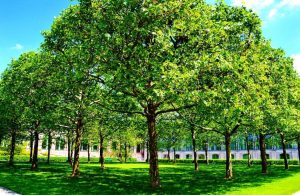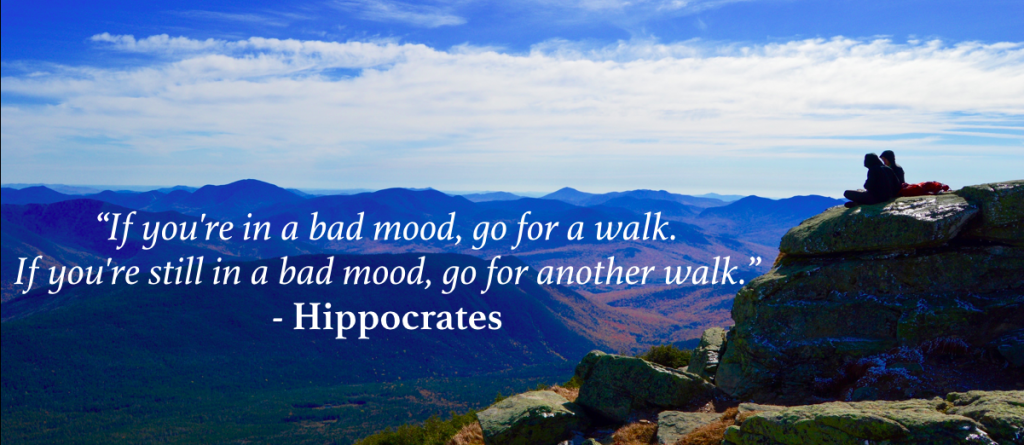Prescribing A Walk In The Woods
Humans are designed to move. Specifically, we’re designed to move throughout nature. Not long ago our well-being was entirely dependent on our ability to navigate our natural environment.
We evolved to walk, run, swim, crawl and climb throughout the wilderness as a means of survival. All of these actions enabled us to hunt, gather, build shelter or avoid being hunted ourselves.
Now, without having to leave the comfort of our homes we can acquire the sustenance, shelter and connection that we were once had to venture into the wilderness for. With everything at our fingertips we no longer have to sweat amongst the trees and dirt.
While it’s more convenient to satisfy our fundamental human needs with the click of a button we sell our health short when we stray from practicing the methods we once used to acquire them.
Movement and nature are a fundamental part of our biological design. Without them, especially in concert with one another there is a major gap in our functional health. Although, we’ve evolved to survive without a physical connection to nature we cannot thrive without it.
It’s well known that our sedentary population is starved for movement but what’s far less acknowledged is that we are also starved for nature.
In his book “The Biophilia Hypothesis” Edward O. Wilson suggested that humans have “an urge to associate with other forms of life.”[i] His belief is that we develop genetic fitness through connection with nature, something that is severely lacking in many 21st century lifestyles.
Since the release of Wilson’s book in 1984 numerous scientists have backed up his hypothesis with some cold hard science.
Japanese researcher Quing, LI. made some amazing discoveries studying “The Effects of Forest Bathing on Natural Killer Cell (NK) Activity and Stress Hormone Levels.” Forest Bathing or “Shinrinyoku” as it is called in Japan means “a leisurely walk in the forest.”
In separate studies of city-bound men and women, Qing Li and his team found that walking in the woods for 2 hours a day over 3 days significantly increased NK cell production and activity while also simultaneously reducing sympathetic stress hormones adrenaline and noradrenaline. Natural Killer cells are a vital component of our immune system whose function is to kill tumors and virus infected cells.[ii]
What’s most exciting about this study is that NK Cell production and activity did not only respond acutely to forest exposure but stayed chronically elevated for 30 days following the subject’s last hiking experience!
Think about the implications that just 6 hours a month in nature could have on your long-term health!
An observational study of over 300,000 patients in the Netherlands found that there was a significant correlation between living near greenspace and frequency of numerous diseases and overall morbidity[iii]

15 of the 24 diseases that were examined showed a significant reduction of occurrence if the patients lived with in one kilometer of greenspace. Some of the most notable impacts were with in coronary heart disease, diabetes and back pain, three of the largest drains on our health care system.
The most significant reduction was seen when looking at the frequency of depression and anxiety, giving hope that nature exposure could be an effective part of treatment for stress related disorders.
So does a leisurely walk in the woods or easy paddle down the river do the trick?
Technically yes. But I think we can do better.
What if we combined nature exposure with aerobic exercise? As desperate as we are for both physical activity and nature I think it’s best practice to combine activities whenever possible.
With well known benefits ranging from improved cardiovascular health to reduction of chronic pain, aerobic exercise could actually exponentially improve the health benefits we derive from spending time outside.
Want to reduce risk of a heart disease?
Adults with a V02 of 26 or less are 70% more likely to die of cardiovascular disease than someone with a VO2 max of 38 or greater. Not to mention, raising your VO2 by 3.5 mL/(kg*min) is 28.5% more effective at improving long term outcomes than taking popular statins like Lipitor or Crestor[iv]
Maybe trade in that statin for a bi-weekly hike?
Afraid of your brain deteriorating as you age?
Aerobic exercise has been shown to be effective at increasing the volume of the prefrontal and temporal cortex in aging populations. These two regions are frequently reported to show substantial age-related deterioration and are most notably affected in Alzheimer’s disease. [v]
Perhaps an intense swim in the ocean would be beneficial at bulking that brain up?
Chances are you have experienced Chronic Pain at some point in your life much like 100 million other Americans.
Aerobic training adaptations have been shown to improve pain tolerance both acutely and chronically meaning that exercise could greatly improve quality of life for those suffering from musculoskeletal pain.[vi] [vii]
What if a bi-weekly swift mountain bike ride could be the missing part your rehab program?
Are you chronically stressed or anxious? Do you struggle to recover between workouts?
Aerobic exercise has been shown to lower anxiety sensitivity and reduce sympathetic responses to stress.[viii][ix][x]
Sounds like a light jog in the woods could serve as a good recovery workout or psychotherapy session.
I could go for days like this but I think you understand the point.
Interaction with nature and aerobic health are central to our biological integrity. When we exercise in nature we fill a major gap in our functional health.
I’m not saying that you need to go crazy on me and hike the Appalachian Trail but I am encouraging you to think about developing functional health outside the gym.
Coaches, maybe start assigning your clients short hikes instead of mini-band drills when they are at home?
Do you train yourself?
In addition to 2-3 days of strength training try dosing in some trail running, hiking, snowshoeing, biking, kayaking or even just an easy walk in the park.
Want to get an aerobic fix?
Put on a heart rate monitor and track your pace. Whatever mode you choose, work to maintain a heart rate from 120-155 beats per minute for at least 30 minutes. If you can go longer than that great, if you struggle to reach 30 minutes that’s fine too, just keep adding time to track your progress.
What important is that we get out side and sweat among the trees, water, snow and dirt. We all came from this and we all will be come it again when we die so why would we spend the better part of our lives in absence of it?
Go outside, move, sweat and Go Wild.[xi]
Kevin
[i] Kellert, Stephen R., and Edward O. Wilson. The biophilia hypothesis. Island Press, 1995.
[ii] Li, Q., et al. “Forest bathing enhances human natural killer activity and expression of anti-cancer proteins.” International journal of immunopathology and pharmacology 20.2 suppl (2007): 3-8.
[iii] Maas, Jolanda, et al. “Morbidity is related to a green living environment.” Journal of epidemiology and community health 63.12 (2009): 967-973.
[iv] Kodama, Satoru, et al. “Cardiorespiratory fitness as a quantitative predictor of all-cause mortality and cardiovascular events in healthy men and women: a meta-analysis.” Jama 301.19 (2009): 2024-2035.
[v] Colcombe, Stanley J., et al. “Aerobic exercise training increases brain volume in aging humans.” The Journals of Gerontology Series A: Biological Sciences and Medical Sciences 61.11 (2006): 1166-1170.
[vi] Jones, Matthew D., et al. “Aerobic training increases pain tolerance in healthy individuals.” Med Sci Sports Exerc 46.8 (2014): 1640-1647.
[vii] Hoffman, Martin D., and Debi Rufi Hoffman. “Does aerobic exercise improve pain perception and mood? A review of the evidence related to healthy and chronic pain subjects.” Current pain and headache reports 11.2 (2007): 93-97.
[viii] Blumenthal, James A., et al. “Aerobic exercise reduces levels of cardiovascular and sympathoadrenal responses to mental stress in subjects without prior evidence of myocardial ischemia.” The American journal of cardiology 65.1 (1990): 93-98.
[ix] Salmon, Peter. “Effects of physical exercise on anxiety, depression, and sensitivity to stress: a unifying theory.” Clinical psychology review 21.1 (2001): 33-61.
[x] Broman-Fulks, Joshua J., et al. “Effects of aerobic exercise on anxiety sensitivity.” Behaviour research and therapy 42.2 (2004): 125-136.
[xi] Ratey, John J. M.D., and Manning, Richard, Go Wild, Little, Brown and Company, New York, 2014.
